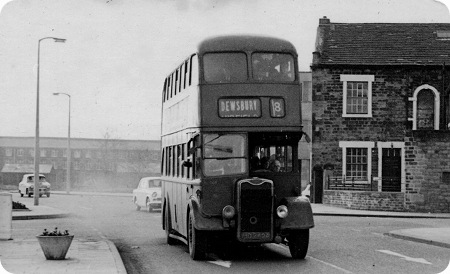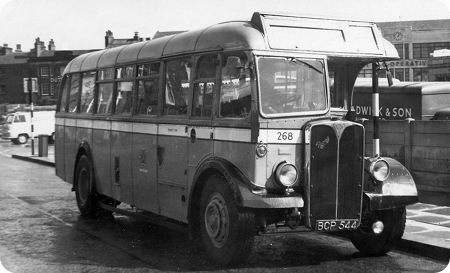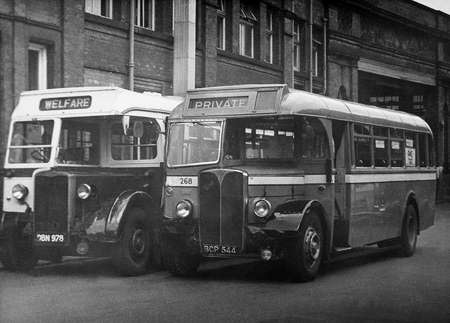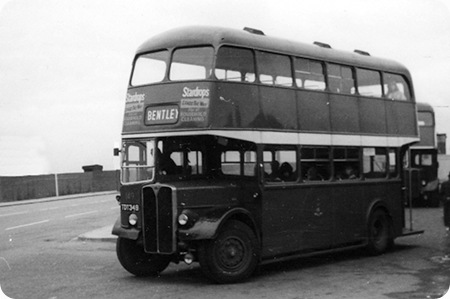
Doncaster Corporation
1956
AEC Regent V MD3RV
Roe H34/28R
If you visit this site on a regular basis the last bus that was on stand was a Sheffield Corporation AEC Regent III that looked like a Regent V here we have a Doncaster Corporation Regent V that looks like a Regent III. It was possible to order the Regent V with an exposed radiator until 1960 which was six years into production before the wide bonnet look took over completely. In 1956 the Bentley trolleybus service in Doncaster was converted to motorbus operation and I think these Regent V buses were acquired to fulfil the part.
The AEC code for this bus was MD3RV which meant this bus had the smaller six cylinder 7.68 litre engine with a four speed synchromesh gearbox and triple servo vacuum brakes.
A full list of Regent V codes can be seen here.
Doncaster was, of course, famous for transferring some of its trolleybus bodies onto PD2 and CVG6 chassis when the trolleys were scrapped. The trolleys had been rebodied fairly recently so the bodies still had lots of life in them, and at least one of the PD2s still survives. They were unmistakable as they retained the thick second body pillar upstairs where the power cables were trunked up to the roof, and on the PDs the body never quite sat right over the windscreen, having a slight overhang.
David Jones
There are actually two survivors of this exercise. All the Daimlers that received the ex trolley bodies were new chassis as were two of the PD2’s however four of the PD2’s were some 16 years old already when their original bodies were scrapped and replaced by an ex trolley body. Both survivors are Leylands and represent 1 each of the ‘old’ and ‘ new’ chassis.
When you realise that a lot of the bodies had themselves originally been built on second hand chassis as Doncaster took advantage of good second hand purchases thrown out as other operators closed down their trolleybus systems you’ll realise what a complicated story this was.
94, the oldest survivor actually received the body off EWT 478 that had originally been new to the nearby Mexborough and Swinton fleet in 1943 with a utility single deck body. The six vehicles of this type operated by M&S were bought by Doncaster in late 1954, the original bodies removed and scrapped and the chassis sent to Roe to be fitted with the new double deck bodies that would eventually find their way onto diesel chassis.The ‘new’ trolleybuses entered service in 1955 but would only have eight years use before the Doncaster trolleybus system closed in 1963. Trolleybus 375 and 94 live at Sandtoft Transport Centre.
Andrew
05/05/12 – 16:49
Three Yorkshire municipal operators bought exposed radiator AEC Regent Vs these being Doncaster, Huddersfield and Leeds. With the exception of the last ones bought by Leeds in 1960 all were short length vehicles. The last Leeds examples were the only ones to carry MCW bodywork and the only ones built to maximum dimensions They looked most imposing and were my favourite Leeds buses
As far as I am aware the only other company to buy exposed radiator AEC Regent Vs was City of Oxford
Chris Hough
06/05/12 – 08:06
How refreshing Chris to hear favourable comment about Leeds 910 – 924. I too admired them greatly and have spent many hours in total trying to get the detractors to tone down their often wildly exaggerated abuse of these handsome buses. My only criticism of them was, from a driver’s point of view, that tall people like me had great difficulty in seeing in the nearside mirror due to the position of the canopy – I notice that on preserved 916 a mirror with a longer arm which will no doubt of cured that little blip – possibly the others were similarly treated while in service ??
Chris Youhill
06/05/12 – 08:06
Chris, my native Nottingham also bought 65 exposed radiator Regent Vs in 1955/56. They came in two almost identical batches with Park Royal bodies. The first 30 (UTV209-238) seated 61. The remaining 35 (XTO239-273) seated 62. They were the last of a long line of Regents that started in 1929 and over the years totalled 478. Subsequently NCT took 44 Leyland PD2/40s in 1958/9 (the first Leylands in the fleet), but reverted to AEC in 1965 for 42 Renowns which were Nottingham’s last half-cabs.
Stephen Ford
06/05/12 – 08:07

Chris Hough mentions the exposed radiator Regent Vs of Leeds City Transport with MCW bodywork, that dated from 1960 until withdrawal in 1975. Here is No. 915, 3915 UB on a rather dismal day in Leeds in April 1970.
Roger Cox
06/05/12 – 08:08
Rhondda Regent Vs 400-424 all had exposed Radiators and Weymann Orion bodies and I’m sure there were other examples.
David Beilby
06/05/12 – 16:47
Roger’s picture clearly shows the extended mirror arm which I mentioned – so presumably they were all similarly treated. The MCW body sat comfortably and tidily on the exposed radiator chassis. Also of interest in this picture is the destination "Kirkstall Forge" – a fairly unusual short working of services 24/5/6/7 from Swarcliffe to Horsforth.
Chris Youhill
06/05/12 – 16:48
Did anybody besides Sheffield have Regent III’s with Regent V grilles?
Eric Bawden
07/05/12 – 09:13
Chris Y mentions the preserved AEC Regent V from Leeds 916 3916UB This bus is non standard compared to the others of the batch as it was given an Atlantean front dome following an argument with a crane in the late sixties
Chris Hough
07/05/12 – 10:53

Another exposed radiator Regent V with the Orion body is seen here in Oxford, wearing the resplendent livery of City of Oxford Motor Services. The lowbridge version of the Orion, as worn by MD3RV304, COMS No.193, 193 BFC, always looked less gawky to my eye than the highbridge variant. The best looking Orion bodies ever built were surely those supplied to Aldershot and District in 1964/65 on Dennis Loline III chassis, where the visual balance was greatly improved by the low level of the lower saloon window line, and then enhanced further by the excellent A&D livery.
Roger Cox
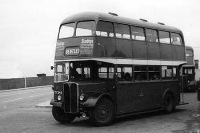 Vehicle reminder shot for this posting
Vehicle reminder shot for this posting
11/01/14 – 07:44
It’s the first time I have been on your site and it has brough back some terrific memories. In the 60s and 70s I worked for Doncaster corporation transport department as a conductor and later a driver.The A.E.C. in your picture is coming of the bus stand on the North Bridge on its way to Bentley, in 1968 I was conductor on one of the Bentley service buses, it was in the summer, a very hot day and we were stood in traffic waiting to get on to the stand, along side us was a cattle truck, my driver was sat with the door slid wide open, a cow on the truck took short and peed on my mate, the door was jammed open, and poor old Jock couldn’t shut it. He was drownded in cow pee, the passengers on the bus burst out laughing and the bus shook from side to side. when we got onto the stand the cab floor had about 6 inches of cow pee in it, poor Jock was soaked to the skin. This is a true story the picture of the AEC brought it flooding back! the driver should be in the Guiness Book Of Records – the only man to be peed on by a cow while driving a bus! thanks for the memories.
Rog Haworth
13/01/14 – 08:36
Chris H, after death and taxes the next thing you can be sure of in this life is of being immediately proved wrong if you post on this forum! Mention has already been made of exposed-radiator Regent Vs with Nottingham and Rhondda – there were actually 27 Rhondda examples, 298/9, 400-24.
I can add East Yorkshire – two distinct batches in the series 634-50 (VKH 34-50). There are two pages on this very forum devoted to these vehicles! www.old-bus-photos.co.uk/?p=8 & www.old-bus-photos.co.uk/?p=937
One exposed radiator Regent V which is often overlooked is this one of Bedwas & Machen. The photo comes from the collection of a regular contributor to this site, see above! I hope he doesn’t mind my linking to it. www.sct61.org.uk/bj9
David Call
15/01/14 – 05:55
In response to Eric B’s question re Regent IIIs with Regent V-style grilles, here’s one with a Regent V-style grille, but obviously not a Regent V-style bonnet. The chassis, a Regent III prototype, remained with AEC as a test chassis for several years, before being sold to Liss & District who had it bodied by Roe as seen here. Later recorded with Creamline of Bordon (an associated concern), and later still with Super of Upminster, it is thought to be depicted here with Creamline.
The Regent III on the left is almost as interesting – it’s production chassis (type 9612A) remained with AEC for almost as long as that of 150AOU, before being bodied, again by Roe, for Liss & District, later passing to Creamline. Could these have been the only Regent IIIs to feature forward entrances from initial bodying? www.flickr.com/photos/
David Call
15/01/14 – 08:57
Yes, but don’t forget the (roughly) 80 Regent IIIs delivered to Sheffield in 1955/56 with Roe and Weymann bodies. They all had Regent V fronts. Sheffield wanted heavyweights and only the lightweight Regent V was available initially. They therefore took delivery of 9613S chassis with Regent V fronts.
David Oldfield
